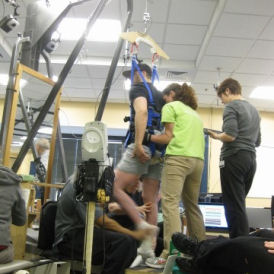Breakthrough helps paraplegic back to his feet
A paralysed man in the United States has been helped to stand and walk again by pioneering medical treatment. He described the change as the “most amazing feeling”.
Rob Summers was completely paralysed below the chest in a road accident in 2006.
But now, thanks to new research, he can stand for several minutes, take repeated steps on a treadmill and voluntarily move his hips, knees, ankles and toes. He has also regained some sexual and bladder function.
Mr Summer’s treatment in the United States was described as a “breakthrough” by the scientists involved.
For someone who for four years was unable to even move a toe, to have the freedom to stand on my own is the most amazing feeling. Paraplegic Rob Summers
Professor Susan Harkema said: “This is a breakthrough. It opens up a huge opportunity to improve the daily functioning of these individuals…but we have a long road ahead.”
Mr Summers said: “This procedure has completely changed my life. For someone who for four years was unable to even move a toe, to have the freedom and ability to stand on my own is the most amazing feeling.
“To be able to pick up my foot and step down again was unbelievable, but beyond all of that my sense of well-being has changed. My physique and muscle tone has improved greatly, so much that most people don’t even believe I am paralyzed. I believe that epidural stimulation will get me out of this chair.”

How the treatment works
The unprecedented results of the research were reported in The Lancet, where the scientists further explained how the treatment worked.
Mr Summer’s treatment involved a combination of a process called epidural spinal cord stimulation and repeated motion training.
Through a device in his back which stimulated Mr Summer’s spinal cord, the scientists could send signals which mimicked the signals sent by the brain to initiate movement, a technique known as direct epidural stimulation.
Once that signal was given via this stimulation, his spinal cord’s “neural network”, combined with sensory input from the legs, could direct the movements necessary to stand – and ultimately step with assistance on a treadmill.
The team had to re-train Mr Summer’s spinal cord “neural networks” in order to be able to act on these signals – a process which took more than two years of motion training. The electrostimulation device was then surgically implanted into Mr Summer’s back, where it could stimulate the spinal cord.
Channel 4 news Science Correspondent takes a look at the remarkable breakthrough and its future impact in helping other paraplegics
Though this research has shown it is possible for a person with a severed spinal cord to take stand and take steps - it doesn't bring us any closer to a "cure" for spinal injuries.
The "breakthrough" of this research is the use of electrodes - implanted under the skin - to show that the innate power of our spinal cord can be recovered several years following spinal injury.
Signals from our brain direct the voluntary movements of standing, walking and running. But the actual execution of those movements such as balancing or taking a step, is, to a large degree, controlled locally by the section of our spinal cord that controls the limbs in question.
An everyday demonstration of the power of our spinal cord is the pain reflex. Touch a hot surface, or prick yourself with a pin, and fast as lighting you will withdraw your hand. That response requires no input from the brain at all - it's controlled entirely by the innate intelligence of your spinal cord.
What the researchers have done is to stimulate the region of Rob Summers' spinal cord that controls his legs. With lots of training, and the assistance of a treadmill, they show the in-built ability of the spinal cord can be recovered.
By helping Mr Summers stand while his spinal cord is stimulated electrically allowed the control of standing to be partly taken over by the spinal cord. Feedback from the nerves in his feet helps maintain the cord's control. By putting Mr Summers on a treadmill the walking motion of his feet again sends signals back to the spinal cord which (while still being stimulated) can then induce his feet to take the next step and so-on.
It's an important demonstration, but it only builds further on existing research that has shown that electrical stimulation of the skin can induce similar - though less complete - results. What's more, Rob Summers - though completely paralysed - retained some sensation in his lower body following his accident. This shows his spinal cord was not entirely severed in his accident. It is yet to be seen whether similar results could be obtained in a patient who has a complete break in their spinal cord.
The holy grail of spinal injury research is to repair the severed connection so that control over the limbs is restored. This latest study doesn't bring that discovery closer to that goal, according to Professor Geoffrey Raisman, a pioneer in spinal repair at University College London. "What this research shows is how to make the best of what is left behind after a spinal injury," he says.
Watch the video below to see the difference between Mr Summer's leg movement without the epidural stimulation; and then with the stimulation.
-
Latest news
-
As India goes to the polls in the world’s largest election – what do British-Indians think?6m

-
Tees Valley: Meet the candidates in one of the biggest contests coming up in May’s local elections4m

-
Keir Starmer says public sector reform will be a struggle7m

-
Nicola Sturgeon’s husband Peter Murrell charged with embezzlement of funds from SNP1m

-
Ukraine might finally get $60billion in American weapons and assistance to defend against Russia3m

-




